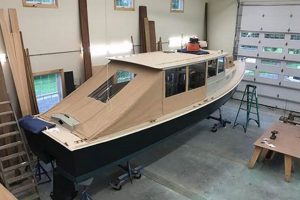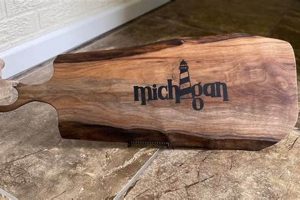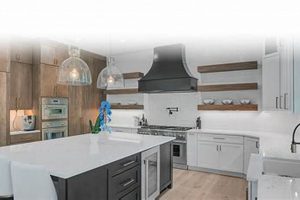The subject of this discussion centers around a specialized sector of craftsmanship that focuses on the design and creation of individualized wood products. These items, often built to specific client requirements, range from furniture and cabinetry to intricate decorative pieces. For instance, a homeowner might commission a unique dining table built to precise dimensions and style preferences, or a business might request custom shelving designed to maximize space and complement its brand aesthetic.
The significance of this particular area lies in its ability to fulfill needs unmet by mass-produced goods. It offers a high degree of personalization, allowing clients to obtain items perfectly suited to their tastes, spatial constraints, and functional requirements. Historically, this type of skilled trade represents a continuation of time-honored traditions, where expertise is passed down through generations. This background ensures a commitment to quality and meticulous attention to detail, resulting in durable, lasting pieces that often become family heirlooms.
The following sections will delve deeper into the specifics of achieving excellence in this field, addressing aspects such as material selection, design considerations, fabrication techniques, and the importance of client communication and satisfaction.
Tips for Exceptional Custom Woodworking
The following guidance offers crucial considerations for producing high-quality, enduring custom wood projects. Adherence to these principles enhances the overall outcome and ensures client satisfaction.
Tip 1: Material Selection is Paramount: The choice of wood species significantly impacts the final product’s aesthetic, durability, and suitability for its intended purpose. Consider factors like hardness, grain pattern, and moisture resistance. For example, using a hardwood like maple for a kitchen countertop ensures resilience against daily wear, while a softwood like pine might be more appropriate for decorative trim.
Tip 2: Detailed Design and Planning are Essential: A comprehensive design phase, including precise measurements, detailed drawings, and clear specifications, is critical. This minimizes errors and ensures the final product aligns with the client’s vision. Employing Computer-Aided Design (CAD) software facilitates accurate visualization and prototyping.
Tip 3: Precision in Joinery Matters: Strong and accurate joinery is fundamental to the structural integrity of any woodworking project. Selecting the appropriate joinery method such as mortise and tenon, dovetail, or dado based on the application is crucial. Precision cutting and fitting ensure lasting stability and prevent future failures.
Tip 4: Surface Preparation is Key to a Flawless Finish: Thorough surface preparation, including sanding and filling imperfections, creates an optimal base for finishing. Proper sanding techniques, progressing through increasingly finer grits, result in a smooth, even surface. Attention to detail at this stage directly affects the quality and longevity of the final finish.
Tip 5: Finishing Requires Skill and Expertise: The selection and application of the appropriate finish protect the wood, enhance its natural beauty, and contribute to its overall durability. Consider factors like UV resistance, moisture protection, and ease of maintenance. Employing multiple coats and allowing adequate drying time between applications is essential.
Tip 6: Proper Equipment Maintenance Maximizes Efficiency: Regularly servicing woodworking tools, including sharpening blades and calibrating machinery, ensures accuracy and efficiency. This prevents material waste, reduces the risk of errors, and extends the lifespan of the equipment.
Tip 7: Environmental Considerations Enhance Sustainability: Prioritize the use of sustainably sourced lumber and environmentally friendly finishes. This minimizes the project’s impact on natural resources and promotes responsible woodworking practices.
By implementing these tips, custom woodworking projects will demonstrate exceptional craftsmanship, durability, and aesthetic appeal. Meticulous attention to detail throughout the entire process, from material selection to finishing, is key to achieving outstanding results.
The subsequent discussion will explore strategies for effective project management and client communication to ensure a seamless and successful workflow.
1. Unparalleled craftsmanship excellence
The phrase “unparalleled craftsmanship excellence,” when applied to custom woodworking, signifies a dedication to achieving the highest standards of quality, precision, and artistry in the creation of bespoke wooden objects. In the context of woodworking businesses, this denotes a commitment to exceeding typical industry benchmarks, setting them apart through the skill, care, and meticulous attention to detail applied to every stage of the production process. This commitment manifests in numerous ways, from the selection of premium materials to the implementation of advanced woodworking techniques and the flawless execution of intricate designs. For example, a custom cabinet maker demonstrating unparalleled craftsmanship would not only use the finest hardwoods, but also employ sophisticated joinery methods, hand-applied finishes, and rigorous quality control measures to ensure the final product is both aesthetically pleasing and structurally sound.
The correlation between unparalleled craftsmanship and the success of custom woodworking businesses is direct. Superior craftsmanship leads to enhanced product durability, increased aesthetic appeal, and improved functionality, resulting in greater customer satisfaction. Positive word-of-mouth referrals, repeat business, and a strong brand reputation are all direct consequences of consistently delivering exceptional woodworking projects. Furthermore, a commitment to excellence can allow a business to command premium pricing, reflecting the value of the superior quality and individualized service offered. This investment in quality can also mitigate future costs, such as repairs or replacements, associated with inferior workmanship or materials. For instance, consider a business specializing in custom-built furniture. If each piece is constructed with meticulous attention to detail and using time-tested techniques, it can withstand decades of use, solidifying the companys reputation for durability and value.
In conclusion, unparalleled craftsmanship is not merely an aspiration within the custom woodworking industry; it is a fundamental requirement for long-term success and a key differentiator in a competitive market. While challenges such as sourcing skilled labor and maintaining consistent quality control exist, businesses that prioritize and uphold a commitment to excellence are best positioned to thrive. This understanding serves as a guiding principle for businesses striving to establish themselves as leaders in the field and a benchmark for customers seeking exceptional quality and personalized service.
2. Bespoke design adaptability
In the realm of specialized woodworking, the phrase “bespoke design adaptability” denotes the capacity to tailor creations to the precise requirements and preferences of individual clients. It is not simply about offering customization options, but rather about possessing the flexibility to modify existing designs, create entirely new ones from conceptual sketches, and seamlessly integrate unique features or materials based on specific requests. This capability is pivotal in distinguishing offerings from mass-produced items, allowing for the realization of functional art that precisely meets a client’s spatial constraints, aesthetic sensibilities, and practical needs. An illustrative example is a homeowner requesting a custom-built entertainment center to fit an irregularly shaped wall, demanding a design that optimizes space, accommodates specific electronics, and complements the existing decor. Success in this endeavor hinges upon the woodworker’s ability to adapt the design iteratively, incorporating feedback and addressing unforeseen challenges that arise during fabrication.
The integration of bespoke design adaptability significantly impacts the value proposition of custom woodworking. It fosters a collaborative relationship between the artisan and the client, empowering the latter with a sense of ownership and control over the final product. This collaboration often extends beyond mere aesthetic considerations to encompass ergonomic factors, accessibility features, and specialized storage solutions. For instance, a professional chef may commission a custom kitchen island tailored to their workflow, incorporating features such as specialized knife storage, integrated cutting boards, and adjustable shelving for various culinary tools. The woodworker, in this scenario, serves as a facilitator, translating the chef’s operational requirements into a functional and aesthetically pleasing piece of furniture. This bespoke approach transcends the limitations of standardized options and delivers a solution optimized for a specific purpose.
In conclusion, bespoke design adaptability serves as a cornerstone of successful custom woodworking practices. The ability to navigate complex client requests, adapt to evolving design parameters, and integrate specialized features is paramount. While challenges such as maintaining design integrity while incorporating client feedback and managing the cost implications of intricate modifications exist, the resulting product offers a level of personalization and functional optimization unattainable through mass production. Consequently, woodworking businesses prioritizing this aspect establish a reputation for innovation, client satisfaction, and lasting value.
3. Premium material selection
The utilization of premium materials constitutes a foundational element in the field of specialized woodworking. It directly influences the aesthetic appeal, structural integrity, and longevity of the finished product. In the context of bespoke creations, this translates to a meticulous process involving the selection of high-grade hardwoods, sustainably sourced veneers, and durable, environmentally conscious finishes. A direct correlation exists between material quality and the perceived value of the custom piece. For instance, opting for kiln-dried cherry wood with consistent grain patterns over a lower-grade alternative will result in a richer visual texture, greater dimensional stability, and enhanced resistance to warping or cracking over time. This initial investment in material quality translates to a superior final product and increased customer satisfaction.
Consider the construction of a custom dining table. The choice of a premium, solid hardwood such as walnut or white oak, carefully selected for its consistent color and minimal defects, directly impacts the table’s structural stability and resistance to wear and tear from daily use. Furthermore, the application of a high-quality, non-toxic finish not only protects the wood from moisture and scratches but also enhances its natural beauty and ensures it is safe for food contact. This combination of superior materials and meticulous craftsmanship yields a product that not only serves its intended function but also becomes a cherished heirloom, representing a lasting investment. Conversely, the use of inferior materials, such as particleboard or low-grade softwoods, will inevitably lead to premature deterioration, diminishing the value and longevity of the piece, regardless of the skill of the craftsman.
In conclusion, the selection of premium materials is not merely a superficial consideration but rather an integral component of high-quality custom woodworking. It is a deliberate choice that reflects a commitment to excellence and a recognition of the enduring value of well-crafted pieces. While the initial cost may be higher, the long-term benefits, including enhanced durability, aesthetic appeal, and customer satisfaction, far outweigh the incremental expense. This understanding is essential for any artisan or business striving to establish a reputation for superior quality and lasting value in the competitive world of specialized woodworking.
4. Functional art creation
Functional art creation, within the framework of specialized woodworking, transcends mere utility. It represents the synthesis of artistic expression and practical application, resulting in objects that serve a purpose while simultaneously engaging the senses and stimulating intellectual appreciation. This intersection is particularly relevant when considering the capabilities of a business specializing in tailored woodworking solutions.
- Aesthetic Integration with Practicality
This facet involves seamlessly blending artistic design principles with the functional requirements of a given object. A custom-built writing desk, for example, may incorporate ergonomic considerations for comfortable use, while also featuring intricate carvings and a visually striking finish. The integration of aesthetic elements does not compromise functionality; rather, it enhances the overall user experience and transforms an ordinary object into a work of art.
- Material as Medium for Expression
Wood, in its various forms, becomes a canvas for artistic exploration. Grain patterns, textures, and coloration are intentionally selected and manipulated to evoke specific emotions or create visual interest. For instance, the use of reclaimed wood with visible imperfections can add a sense of history and character to a piece, while the incorporation of contrasting wood species can create dynamic visual patterns. The choice of material is not solely based on structural properties but also on its potential for artistic expression.
- Unique and Individualized Design
Functional art inherently avoids mass production and standardization. Each piece is conceived and crafted as a singular entity, reflecting the unique vision of the artisan and the specific needs of the client. This may involve incorporating personalized details, such as family crests or meaningful symbols, or adapting the design to seamlessly integrate with the surrounding environment. The resulting object becomes a testament to individuality and a reflection of personal identity.
- Elevated Craftsmanship and Attention to Detail
The creation of functional art demands an unwavering commitment to craftsmanship and a meticulous attention to detail. Every joint, every curve, and every surface finish is executed with precision and care. This level of dedication extends beyond structural integrity to encompass aesthetic perfection. A hand-carved detail, a perfectly aligned drawer, or a flawlessly applied finish elevates the object from a mere functional item to a piece of art that can be admired and appreciated for generations.
These facets are intrinsically linked to the ethos of specialized woodworking, particularly when considering businesses focused on custom projects. The ability to integrate artistic expression with practical functionality, to transform raw materials into works of art, and to deliver unique and individualized designs is what distinguishes specialized woodworking from conventional manufacturing. This focus on functional art creation allows businesses to cater to clients who seek more than just utility; they seek objects that enhance their lives aesthetically, emotionally, and intellectually.
5. Client-centric approach
A client-centric approach, within the context of specialized woodworking, underscores the prioritization of customer needs, preferences, and overall satisfaction throughout the entire project lifecycle. In specialized woodworking, this begins with initial consultations to thoroughly understand client expectations regarding design, functionality, budget, and timelines. Clear and consistent communication forms the bedrock of this approach, ensuring transparency and collaborative decision-making at each stage, from material selection to final installation. For example, if a client seeks a custom-built library, a client-centric approach would involve detailed discussions about storage requirements, aesthetic preferences (wood species, finish, style), and integration with existing architectural features, resulting in a design that accurately reflects the client’s vision and practical needs.
The practical significance of a client-centric strategy becomes apparent in the reduction of errors, minimized rework, and enhanced client satisfaction. Proactive communication mitigates potential misunderstandings and allows for timely adjustments based on client feedback. Moreover, a focus on building strong client relationships fosters trust and encourages repeat business. Consider a scenario where a client requests a modification to a design after the initial fabrication has commenced. A client-centric business would address the request promptly, assess the feasibility and cost implications, and collaborate with the client to find a mutually agreeable solution, even if it necessitates adjustments to the production schedule. This flexibility and commitment to customer satisfaction differentiate such businesses from those that prioritize efficiency over client needs.
Challenges associated with maintaining a client-centric approach include managing diverse client expectations, balancing customization with production efficiency, and adapting to evolving design trends. However, businesses that successfully integrate this strategy into their core operations realize tangible benefits, including enhanced brand reputation, increased referrals, and long-term client loyalty. By prioritizing the client experience and consistently exceeding expectations, specialized woodworking businesses can establish a strong competitive advantage and secure a sustainable future. This understanding, when implemented effectively, transforms custom woodworking from a mere transaction into a collaborative and rewarding experience for both the artisan and the client.
Frequently Asked Questions
The following section addresses common inquiries regarding custom woodworking, providing clarity and insight into the processes and considerations involved.
Question 1: What factors influence the cost of custom woodworking projects?
The price is subject to fluctuations based on material selection, project complexity, dimensions, and finish requirements. More intricate designs, premium materials, and extensive labor hours contribute to higher overall expenses. A detailed consultation facilitates accurate cost estimation.
Question 2: How long does the custom woodworking process typically take?
Project durations vary widely, dependent on design complexity, material availability, and current workload. Simpler projects may conclude within weeks, while intricate undertakings necessitate several months. A project timeline is provided following design finalization.
Question 3: What types of wood are most suitable for custom furniture?
The selection is dependent on intended use, aesthetic preferences, and budget considerations. Hardwoods, such as oak, maple, and cherry, offer durability and visual appeal, while softwoods, such as pine and cedar, present cost-effective alternatives for specific applications. Consultations aid in determining the optimal wood species.
Question 4: Is it possible to incorporate existing design elements into a custom woodworking project?
Integration of existing design elements is frequently achievable. Clients are encouraged to provide sketches, photographs, or samples for consideration. Compatibility assessments are conducted to ensure seamless integration with the new design.
Question 5: What is the process for requesting a custom woodworking quote?
Quote requests are initiated through contacting our office via phone or email. Providing detailed project specifications, including dimensions, materials, and design preferences, enables accurate quote preparation. On-site consultations are available for complex projects.
Question 6: What warranty or guarantee is offered on custom woodworking projects?
Warranty provisions vary depending on the specific project and materials employed. Details regarding warranty coverage, including duration and limitations, are outlined in the project agreement. Proper care and maintenance are crucial for preserving the longevity of custom pieces.
Custom woodworking provides unique prospects for the construction of enduring and attractive pieces that precisely meet specific requirements. A comprehensive understanding of the processes concerned facilitates successful project execution and maximises client satisfaction.
The subsequent section focuses on maintaining custom woodworking creations, and it will cover appropriate cleaning procedures.
Concluding Remarks on Yoder’s Custom Woodworking
This exposition has delved into the fundamental aspects of custom woodworking, underscoring the importance of material selection, design adaptability, craftsmanship excellence, and a client-centric approach. “Yoder’s Custom Woodworking,” in this context, represents a commitment to individualized design and construction. Functional art creation, coupled with the aforementioned elements, yields lasting value and bespoke quality.
The future of this specialized trade relies on continued dedication to sustainable practices, innovative design solutions, and the preservation of traditional skills. Prioritizing client needs and maintaining uncompromising standards will secure enduring relevance within an evolving market. “Yoder’s Custom Woodworking” endeavors to achieve these ideals, delivering not merely wood products, but enduring legacies.







